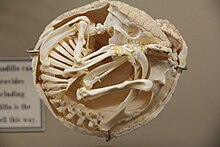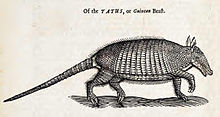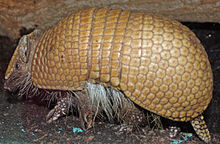Armadillo
| Armadillo Temporal range: Late Paleocene – Recent
| |
|---|---|

| |

| |
| From top to bottom †Glyptodon, nine-banded armadillo (Dasypus novemcinctus), pink fairy armadillo (Chlamyphorus truncatus) | |
| Scientific classification | |
| Domain: | Eukaryota |
| Kingdom: | Animalia |
| Phylum: | Chordata |
| Class: | Mammalia |
| Superorder: | Xenarthra |
| Order: | Cingulata |
| Families | |
| |


Armadillos (
Living armadillos are characterized by a leathery
Recent genetic research has shown that the megafaunal glyptodonts (up to 1.5 metres (4.9 ft) tall with maximum body masses of around 2 tonnes), which became extinct around 12,000 years ago are true armadillos more closely related to all other living armadillos than to Dasypus (the long-nosed or naked-tailed armadillos). Armadillos are currently classified into two families, Dasypodidae, with Dasypus as the only living genus, and Chlamyphoridae, which contains all other living armadillos as well as the glyptodonts.[1]
Etymology
The word armadillo means "little armored one" in Spanish;[2][3] it is derived from "armadura" (armor), with the diminutive suffix "-illo" attached. While the phrase "little armored one" would translate to "armadito" normally, the suffix "-illo" can be used in place of "-ito" when the diminutive is used in an approximative tense.[4] The Aztecs called them āyōtōchtli [aːjoːˈtoːt͡ʃt͡ɬi], Nahuatl for "turtle-rabbit": āyōtl [ˈaːjoːt͡ɬ] (turtle) and tōchtli [ˈtoːt͡ʃt͡ɬi] (rabbit).[5] The Portuguese word for "armadillo" is tatu which is derived from the Tupi language[6] ta' "bark, armor" and tu "dense";[7] and used in Argentina, Bolivia, Brasil, Paraguay and Uruguay; similar names are also found in other, especially European, languages.
Other various vernacular names given are:
- quirquincho (from Quechua: kirkinchu[8]) in Argentina, Bolivia, Chile, Colombia and Peru;
- cuzuco (from Nahuatl) in Costa Rica, El Salvador, Honduras and Nicaragua;
- mulita in Argentina and Uruguay;
- peludo in Argentina, Chile, Colombia and Uruguay;
- piche in Argentina, Brasil, Chile, Colombia and Paraguay;
- cachicamo in Colombia and Venezuela
- gurre in Tolima, Caldas and Antioquia, Colombia;
- jerre-jerre in Caribbean Colombia;
- jueche in southeast Mexico;
- toche in the state of Veracruz, Mexico;
- carachupa in Perú.
Classification
Family Dasypodidae
- Subfamily Dasypodinae
- Genus Dasypus

1658 woodcut of an armadillo - Nine-banded armadillo or long-nosed armadillo, Dasypus novemcinctus
- Seven-banded armadillo, Dasypus septemcinctus
- Southern long-nosed armadillo, Dasypus hybridus
- Llanos long-nosed armadillo, Dasypus sabanicola
- Greater long-nosed armadillo, Dasypus kappleri
- Hairy long-nosed armadillo, Dasypus pilosus
- Yepes's mulita, Dasypus yepesi
- †Beautiful armadillo, Dasypus bellus
- †Dasypus neogaeus
- Genus †Stegotherium
- Genus Dasypus
Family Chlamyphoridae
- Subfamily Chlamyphorinae
- Genus Calyptophractus
- Greater fairy armadillo, Calyptophractus retusus
- Genus Chlamyphorus
- Pink fairy armadillo, Chlamyphorus truncatus
- Genus
- Subfamily Euphractinae
- Genus Chaetophractus

Screaming hairy armadillo - Screaming hairy armadillo, Chaetophractus vellerosus
- Big hairy armadillo, Chaetophractus villosus
- Andean hairy armadillo, Chaetophractus nationi
- Genus †Macroeuphractus
- Genus †Paleuphractus
- Genus †Proeuphractus
- Genus †Doellotatus
- Genus †Peltephilus
- †Horned armadillo, Peltephilus ferox
- Genus Euphractus
- Six-banded armadillo, Euphractus sexcinctus
- Genus Zaedyus
- Pichi, Zaedyus pichiy
- Genus Chaetophractus
- Subfamily Tolypeutinae
- Genus †Kuntinaru[9]
- Genus Cabassous

Southern three-banded armadillo - Northern naked-tailed armadillo, Cabassous centralis
- Chacoan naked-tailed armadillo, Cabassous chacoensis
- Southern naked-tailed armadillo, Cabassous unicinctus
- Greater naked-tailed armadillo, Cabassous tatouay
- Genus Priodontes
- Giant armadillo, Priodontes maximus
- Genus Tolypeutes
- Southern three-banded armadillo, Tolypeutes matacus
- Brazilian three-banded armadillo, Tolypeutes tricinctus
† indicates extinct taxon
Phylogeny
Below is a recent simplified phylogeny of the xenarthran families, which includes armadillos.[10][11] The dagger symbol, "†", denotes extinct groups.
| Xenarthra |
| ||||||||||||||||||
Evolution
Recent genetic research suggests that an extinct group of giant armored mammals, the glyptodonts, should be included within the lineage of armadillos, having diverged some 35 million years ago, more recently than previously assumed.[12]
Distribution
Like all of the Xenarthra lineages, armadillos originated in
Today, all extant armadillo species are still present in South America. They are particularly diverse in Paraguay (where 11 species exist) and surrounding areas. Many species are endangered. Some, including four species of Dasypus, are widely distributed over the Americas, whereas others, such as Yepes's mulita, are restricted to small ranges. Two species, the northern naked-tailed armadillo and nine-banded armadillo, are found in Central America; the latter has also reached the United States, primarily in the south-central states (notably Texas), but with a range that extends as far east as North Carolina and Florida, and as far north as southern Nebraska and southern Indiana.[14] Their range has consistently expanded in North America over the last century due to a lack of natural predators. Armadillos are increasingly documented in southern Illinois and are tracking northwards due to climate change.[15]
Characteristics
Size
The smallest species of armadillo, the pink fairy armadillo, weighs around 85 g (3.0 oz) and is 13–15 cm (5.1–5.9 in) in total length. The largest species, the giant armadillo, can weigh up to 54 kg (119 lb), and can be 150 cm (59 in) long.[16]
Diet and predation
The diets of different armadillo species vary, but consist mainly of insects, grubs, and other invertebrates. Some species, however, feed almost entirely on ants and termites.
They are prolific diggers. Many species use their sharp claws to dig for food, such as

Armadillos have very poor eyesight, and use their keen sense of smell to hunt for food.
Body temperature
In common with other xenarthrans, armadillos, in general, have low
Skin
The armor is formed by plates of dermal bone covered in relatively small overlapping epidermal scales called "scutes" which are composed of keratin.[19] The skin of an armadillo can glow under ultraviolet light.[20] Most species have rigid shields over the shoulders and hips, with a number of bands separated by flexible skin covering the back and flanks. Additional armor covers the top of the head, the upper parts of the limbs, and the tail. The underside of the animal is never armored and is simply covered with soft skin and fur.[21] This armor-like skin appears to be an important defense for many armadillos, although most escape predators by fleeing (often into thorny patches, from which their armor protects them) or digging to safety. Only the South American three-banded armadillos (Tolypeutes) rely heavily on their armor for protection.
Defensive behavior
When threatened by a
Movement
Armadillos have short legs, but can move quite quickly. The nine-banded armadillo is noted for its movement through water,[23] which is accomplished via two different methods: it can walk underwater for short distances, holding its breath for as long as six minutes; or, to cross larger bodies of water, it can increase its buoyancy by swallowing air to inflate its stomach and intestines.[24]
Reproduction
Armadillos and humans
Science and education
Armadillos are often used in the study of
The armadillo is also a natural reservoir for Chagas disease.[31]
The nine-banded armadillo also serves science through its unusual reproductive system, in which four genetically identical offspring are born, the result of one original egg.
Even though they have a leathery, tough shell, Armadillos, (mainly Dasypus) are common roadkill due to their habit of jumping 3–4 ft vertically when startled, which puts them into collision with the underside of vehicles.[35] Wildlife enthusiasts are using the northward march of the armadillo as an opportunity to educate others about the animals, which can be a burrowing nuisance to property owners and managers.[32]
Culture

Armadillo shells have traditionally been used to make the back of the charango, an Andean lute instrument.
In certain parts of Central and South America, armadillo meat is eaten; it is a popular ingredient in Oaxaca, Mexico. During the Great Depression, Americans were known to eat armadillo, known begrudgingly as "Hoover hogs", a nod to the belief that President Herbert Hoover was responsible for the economic despair facing the nation at that time.[36][37]
A whimsical account of The Beginning of the Armadillos is one of the chapters of Rudyard Kipling's Just So Stories 1902 children's book.[38] The vocal and piano duo Flanders and Swann recorded a humorous song called "The Armadillo".[39]
See also
- Armadillo shoe
- Echidnas, a type of monotreme with a defensive keratin body covering
- Hedgehogs, another mammal group with defensive keratin body coverings
- Pangolins, another mammal group with defensive keratin body coverings
- Porcupines, another mammal group with defensive keratin body coverings
References
- S2CID 3720645.
- ^ "armadillo, armadilla | Definición | Diccionario de la lengua española | RAE - ASALE". Archived from the original on 30 March 2023. Retrieved 4 April 2023.
- ^ "armadillo | Etymology, origin and meaning of armadillo by etymonline". www.etymonline.com. Archived from the original on 28 March 2023. Retrieved 28 March 2023.
- S2CID 194628023.
- in Nahuatl Dictionary, by the Wired Humanities Projects, Stephanie Wood (ed.) Retrieved 2015-07-22.
- ^ FERREIRA, A.B.H. Novo Dicionário da Língua Portuguesa. Segunda edição. Rio de Janeiro: Nova Fronteira, 1986. p. 1 653
- ISBN 9788588075337.
- Real Academia Española. Archivedfrom the original on 7 March 2023. Retrieved 27 January 2023.
- PMID 21288952.
- PMID 26878870.
- .
- ^ "Study finds relationship between glyptodonts, armadillos". AMNH. Archived from the original on 28 February 2016. Retrieved 22 February 2016.
- ^ PMID 21125025.
- ^ "Armadillos slinking their way into Indiana". TheIndyChannel. Associated Press. 7 June 2014. Archived from the original on 9 June 2014. Retrieved 16 June 2014.
- ^ "Armadillos have arrived in downstate Illinois and are heading north — yes, you might someday see an armadillo in your backyard". Chicago Tribune. 14 May 2022. Archived from the original on 17 May 2022. Retrieved 17 May 2022.
- ^ a b "Armadillos, Armadillo Pictures, Armadillo Facts". National Geographic. 12 March 2010. Archived from the original on 6 September 2011. Retrieved 22 July 2015.
- ^ Freeman, Patricia W.; Genoways, Hugh H. (December 1998). "Recent Northern Records of the Nine-banded Armadillo (Dasypodidae) in Nebraska". The Southwestern Naturalist. 43 (4): 491–504. Archived from the original on 11 June 2011. Retrieved 7 June 2010.
- JSTOR 1380307.
- ^ Yates, Paige (30 October 2020). "Armadillo". BiologyDictionary.net. Biology Dictionary. Archived from the original on 8 September 2021. Retrieved 8 September 2021.
The plates of bone are covered in small overlapping epidermal scales called scutes, which are composed of keratin.
- ^ Travouillon, Kenny; Cooper, Christine Elizabeth; Bouzin, Jemmy; Umbrello, Linette; Lewis, Simon; Conversation, The. "From glowing cats to wombats, fluorescent mammals are much more common than you'd think". phys.org. Retrieved 6 October 2023.
- ^ ISBN 978-0-87196-871-5.
- ^ "How high can a nine-banded armadillo jump?". Everyday Mysteries: Fun Science Facts from the Library of Congress. Library of Congress. 12 February 2009. Archived from the original on 6 December 2009. Retrieved 17 December 2009.
- ISBN 978-0-8061-8921-5.
- ^ Vijayaraghavan, R. (2009). "Nine-banded Armadillo Dasypus novemcinctus Animal Model for Leprosy (Hansen's Disease)". Scandinavian Journal of Laboratory Animal Sciences. 36 (2): 167–176. Archived from the original on 23 January 2022. Retrieved 22 July 2015.
- from the original on 15 February 2014. Retrieved 30 August 2012.
- (PDF) from the original on 9 October 2022. Retrieved 4 May 2017.
- ^ a b Harris, Gardiner (27 April 2011). "Armadillos Can Transmit Leprosy to Humans, Federal Studies Confirm". The New York Times. Archived from the original on 4 May 2011. Retrieved 3 May 2011.
- ^ Guiden, Mary (June 2018). "New evidence that wild armadillos spread leprosy to humans". Colorado State University. Retrieved 16 November 2023.
- PMID 26583204.
- ^ PMID 21524213.
- PMID 3128127.
- ^ a b Schaefer, Joseph M.; Hostetler, Mark E. (January 1998). "The Nine-banded Armadillo (Dasypus novemcinctus)". University of Florida, IFAS Extension. Archived from the original on 13 July 2001. Retrieved 17 December 2009.
- ^ (PDF) from the original on 9 October 2022.
- S2CID 86435985.
- ^ "How high can a nine-banded armadillo jump?". Library of Congress. Retrieved 31 August 2020.
- ^ "Armadillos as Food". armadillo-online.org. Archived from the original on 24 October 2019. Retrieved 21 November 2019.
- ^ "The Ordeal of Herbert Hoover, Part 2". National Archives. 15 August 2016. Archived from the original on 1 January 2020. Retrieved 21 November 2019.
- ^ Kipling, Rudyard (1902). "The Beginning of the Armadillos". Just So Stories. Macmillan. Archived from the original on 9 July 2021. Retrieved 6 July 2021.
- OCLC 973628714– via Open WorldCat.
Further reading
- Gardner, A. (2005). OCLC 62265494.
- Superina, Mariella; Pagnutti, Noralí; Abba, Agustín M. (2014). "What do we know about armadillos? An analysis of four centuries of knowledge about a group of South American mammals, with emphasis on their conservation". Mammal Review. 44 (1): 69–80. hdl:11336/26184.
External links
- . Encyclopædia Britannica. Vol. 2 (9th ed.). 1878. pp. 544–545.
- "Armadillo online" website hosted by zoologist Dr. Joshua Nixon
- Photographs of armadillo rolling into a ball



